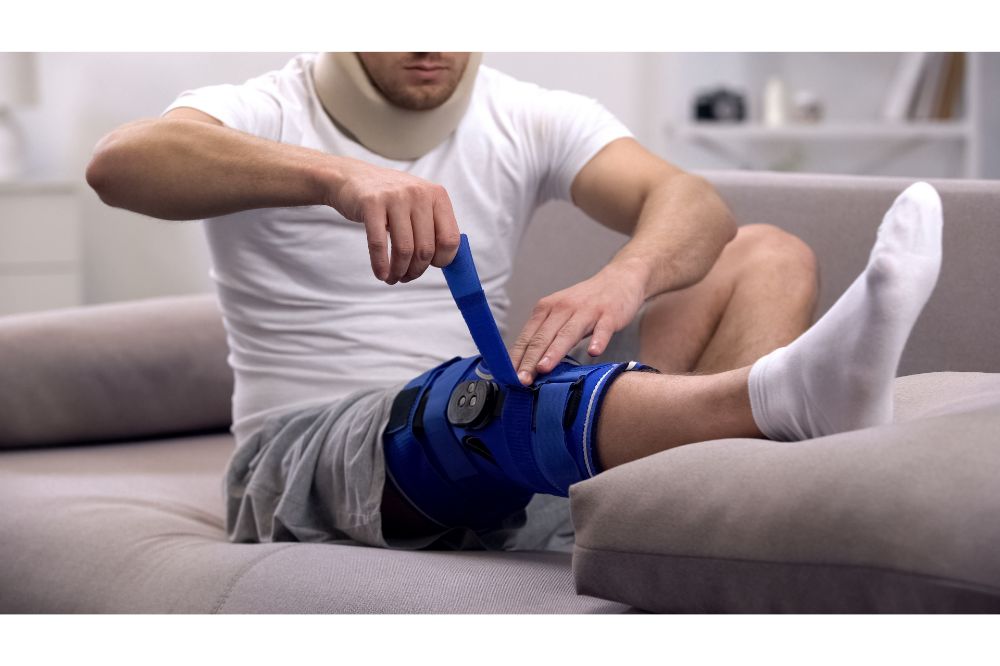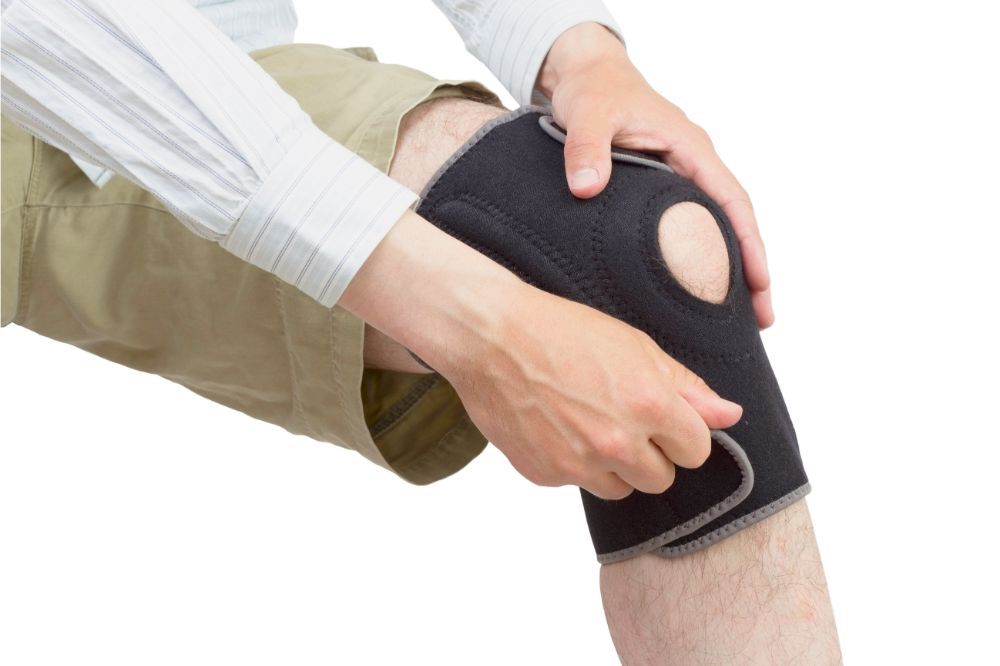You already know that a knee brace will significantly impact the healing process of your knee.
However, did you know that the way you wear it also affects your recovery period?
Yes, knee braces often include straps that allow you to adjust the tightness or looseness of their fit.
With this level of importance, it brings forth one essential question. How tight should a knee brace be?
Here are some insights on how you can guarantee this.

How Tight Should a Knee Brace Be?
If you’ve ever wondered how tight should a knee brace be, the answer is actually pretty straightforward.
It should be as close to your skin as possible. The straps must be adjusted to a point where the active knee brace is immovable from its position despite constant movement.
That said, it’s worth noting that while it should wrap your knees firmly, it should not limit your knee’s range of motion, as though you’re dragging them along.
How To Ensure Proper Knee Brace Fit
Merely describing the feeling of the knee brace’s fit is not enough to ensure that it is aiding your healing process.
Thankfully, definitive guidelines allow you to get the right fit.
Firstly, of course, you must ensure that you are actually using the right type of brace for your knee injury. It’s best to consult a physical therapist for this.
Once you get that, here are some guidelines you can follow to achieve the right size and fit:
Upper Knee Area
If your doctor prescribes you to wear a knee compression sleeve, you first need to measure the circumference of the lower part of your thigh just above your upper knee.
Grab a measuring tape and bend your knee at a 30-degree angle. Next, place the starting point of the measuring tape on your patella or kneecap.
Run the measuring tape up your thigh and take note of the 14-centimeter mark. After doing so, run the measuring tape across this area to get the circumference of your thigh.
Take note of the measurement in inches and centimeters before looking for knee sleeves that have this fit.
Calf Circumference
If a healthcare professional prescribes you to wear an orthopedic or a hinged knee brace, your calf is what you need to measure.
To do so, grab your measuring tape and, again, bend your knee at a 30-degree angle.
Now, you need to run the measuring tape down your calf instead of running up your thigh. Take note of the 13-centimeter or five-inch mark.
Next, run the measuring tape across the calf to get its circumference. This is the size of a hinged knee brace that you need to get.
We suggest you check out the Bodyprox Hinged Knee Brace, as they have a quite detailed size chart.
Universal-Sized Knee Braces
Universal-sized knee braces are also like knee compression sleeves. The only difference is that they don’t have adjustable straps.
Moreover, they are only sometimes measured based on circumference.
Instead, their unit of measurement is the same as clothes, from small to extra-large or even double extra-large.
To get your size, you need to extend your knee fully. Next, use the tape measure to get the circumference of your knee joint.
You can do this by running the measuring tape across the patella or kneecap.
After getting the circumference, check the size chart of the compression sleeves you wish to get. Choose the one where your knee joint circumference falls within.
Two-Finger Test
The “two-finger” method is perhaps the most popular technique for measuring the correct knee brace size and fit.
This method is used in all types of knee braces and allows you to ensure your injured knee is getting the right support from the brace.
To do this, wear the knee brace like you normally would. While standing, slide two of your fingers into the straps.
If you cannot do so, the knee brace is too tight. So, make sure you loosen it a bit.
On the other hand, if your two fingers slid into the straps without any kind of resistance whatsoever, this could indicate that the brace is too loose. Therefore, you need to tighten it.
Once you got the right fit, try walking around while observing how the brace interacts with your knee.
Check that the brace does not restrict your knee movement while ensuring it does not fall off.
In other words, there should be some level of restriction or resistance between the brace and your knee, but just enough that it doesn’t slide off or limit your range of movement.

How About the Tightness of Unloader Knee Braces?
An unloader brace is commonly prescribed to patients with knee osteoarthritis or torn meniscus.
One in five people older than 45 suffer from this osteoarthritis, and an unloader brace allows them to perform everyday activities with ease.
It unloads the weight from the affected area of the knee joint and transfers it to the other side, hence the term “unloader.”
For this type of knee brace, you can use the two-finger method we listed.
That said, keep in mind that the hinges of this type of brace are also very important.
You need to adjust them to the right angle so that the brace can provide your knee with the support necessary for physical activities.
It’s best to consult your physical therapist regarding the hinge adjustment of the unloader brace.
If you suffer from OA, it’s best to use a knee brace specifically designed for this condition. The Cloned Kitty OA Unloading Knee Brace is a great option.
Importance of Properly Fitted Knee Brace
As you can imagine, following the fitting instructions above is quite a task, but why is it important? Why the need to make sure the knee brace fits perfectly?
Here are some knee brace benefits that you get when you get the right fit:
Prevents Further Injury
Perhaps the most important benefit of a properly fitted knee brace is preventing further injury.
If you’re suffering from a torn ligament, a knee brace helps avoid engaging this ligament even further.
However, if the brace you’re wearing is too loose, it can’t keep your knee stable. When there’s insufficient support, there is a higher risk that the torn ligament will worsen.
In a worst-case scenario, minor ligament injuries can escalate to a complete tear or detachment from the bones as you continuously perform physical activities without adequate support.
Instead of only having to wear braces, instances such as these may require knee surgery to reattach the ligament.
Improved Blood Flow
Another crucial benefit of a properly fitted knee brace is how it improves blood flow.
A knee brace that’s too tight restricts blood circulation around your knees. As a result, your knees receive less oxygen and nutrients.
It means that your knee injury will take a longer time to heal.
Furthermore, because of the restricted blood flow, there is little to no reduction of inflammation in the injured area.
As such, you might continue to experience immense knee pain.
You can also combine the benefits of a knee brace with the healing effects of an anti-inflammatory cream for faster recovery.
Check out the Penetrex Joint & Muscle Therapy if you’re looking for one.
Comfort
Lastly, a properly fitted knee brace keeps you comfortable.
If it’s too loose, you might be annoyed with how often you have to reposition the knee brace so it’s right at the joint.
If it is too tight, the constant friction between the brace and your skin may lead to skin irritation. The restricted blood circulation can also cause tremendous discomfort.
This is vital because some physical therapy programs require you to wear your knee brace even when you go to bed.
If it’s too uncomfortable, you may find it difficult to fall asleep, which is another problem of its own.
The Importance of Knee Brace Fit
How tight should a knee brace be?
Basically, you just have to ensure that it doesn’t restrict your blood flow or fall off your knee. This guarantees you the right amount of support for your injury to heal.
You just have to make sure that you’re also using the right type of knee brace in the first place.